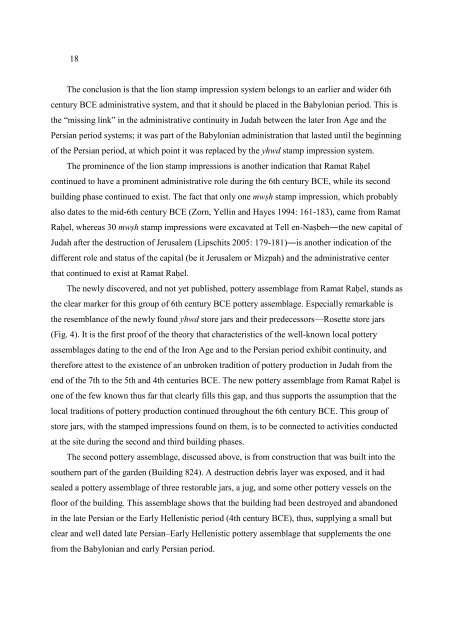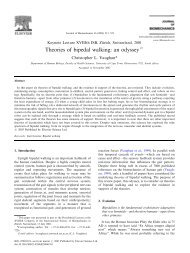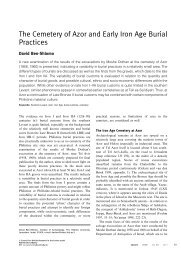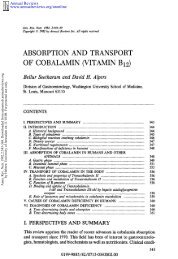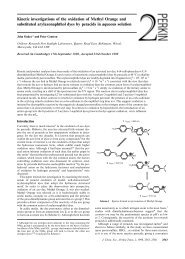The Riddle of Ramat Raḥel: The Archaeology of a Royal Persian ...
The Riddle of Ramat Raḥel: The Archaeology of a Royal Persian ...
The Riddle of Ramat Raḥel: The Archaeology of a Royal Persian ...
Create successful ePaper yourself
Turn your PDF publications into a flip-book with our unique Google optimized e-Paper software.
18<strong>The</strong> conclusion is that the lion stamp impression system belongs to an earlier and wider 6thcentury BCE administrative system, and that it should be placed in the Babylonian period. This isthe “missing link” in the administrative continuity in Judah between the later Iron Age and the<strong>Persian</strong> period systems; it was part <strong>of</strong> the Babylonian administration that lasted until the beginning<strong>of</strong> the <strong>Persian</strong> period, at which point it was replaced by the yhwd stamp impression system.<strong>The</strong> prominence <strong>of</strong> the lion stamp impressions is another indication that <strong>Ramat</strong> <strong>Raḥel</strong>continued to have a prominent administrative role during the 6th century BCE, while its secondbuilding phase continued to exist. <strong>The</strong> fact that only one mwṣh stamp impression, which probablyalso dates to the mid-6th century BCE (Zorn, Yellin and Hayes 1994: 161-183), came from <strong>Ramat</strong><strong>Raḥel</strong>, whereas 30 mwṣh stamp impressions were excavated at Tell en-Naṣbeh―the new capital <strong>of</strong>Judah after the destruction <strong>of</strong> Jerusalem (Lipschits 2005: 179-181)―is another indication <strong>of</strong> thedifferent role and status <strong>of</strong> the capital (be it Jerusalem or Mizpah) and the administrative centerthat continued to exist at <strong>Ramat</strong> <strong>Raḥel</strong>.<strong>The</strong> newly discovered, and not yet published, pottery assemblage from <strong>Ramat</strong> <strong>Raḥel</strong>, stands asthe clear marker for this group <strong>of</strong> 6th century BCE pottery assemblage. Especially remarkable isthe resemblance <strong>of</strong> the newly found yhwd store jars and their predecessors—Rosette store jars(Fig. 4). It is the first pro<strong>of</strong> <strong>of</strong> the theory that characteristics <strong>of</strong> the well-known local potteryassemblages dating to the end <strong>of</strong> the Iron Age and to the <strong>Persian</strong> period exhibit continuity, andtherefore attest to the existence <strong>of</strong> an unbroken tradition <strong>of</strong> pottery production in Judah from theend <strong>of</strong> the 7th to the 5th and 4th centuries BCE. <strong>The</strong> new pottery assemblage from <strong>Ramat</strong> <strong>Raḥel</strong> isone <strong>of</strong> the few known thus far that clearly fills this gap, and thus supports the assumption that thelocal traditions <strong>of</strong> pottery production continued throughout the 6th century BCE. This group <strong>of</strong>store jars, with the stamped impressions found on them, is to be connected to activities conductedat the site during the second and third building phases.<strong>The</strong> second pottery assemblage, discussed above, is from construction that was built into thesouthern part <strong>of</strong> the garden (Building 824). A destruction debris layer was exposed, and it hadsealed a pottery assemblage <strong>of</strong> three restorable jars, a jug, and some other pottery vessels on thefloor <strong>of</strong> the building. This assemblage shows that the building had been destroyed and abandonedin the late <strong>Persian</strong> or the Early Hellenistic period (4th century BCE), thus, supplying a small butclear and well dated late <strong>Persian</strong>–Early Hellenistic pottery assemblage that supplements the onefrom the Babylonian and early <strong>Persian</strong> period.


